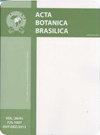A new endangered species of Mollinedia (Monimiaceae, Laurales) endemic to the Atlantic forest in the state of Espírito Santo, Brazil, supported by morphology and genome size estimation
IF 1.1
4区 生物学
Q4 PLANT SCIENCES
引用次数: 0
Abstract
Mollinedia (Monimiaceae) presents numerous microendemic species, and its centre of diversity is in the Brazilian Atlantic rainforest, where more than half of the species occur. The taxonomy of microendemic species can be challenging because their morphological and genetic variations can be interpreted as a response to geographic isolation rather than a circumscription for different species. In this paper, we describe Mollinedia pignalii Lírio & Pauli, a microendemic species from the Espírito Santo state, Brazil. Vegetatively, M. pignalii is similar to Mollinedia elegans Tul. and Mollinedia schottiana (Spreng.) Perkins; however, it presents the following differences: white-puberulous leaves, staminate flowers with a flat receptacle and 6 to 14 stamens, white-puberulous pistillate flowers with a cupuliform receptacle and 8 to 22 carpels, and white-puberulous drupelets. Due to the similarity between the three species, M. pignalii has been collected and deposited in herbaria under different names. Here, we describe the new species based on morphology and genome size, a comparison with similar species, and ecological comments in an integrative approach. We also provide its conservation status and an identification key for the species of Monimiaceae occurring in the state of Espírito Santo.巴西圣托Espírito大西洋森林特有的一种新的濒危物种Mollinedia (Monimiaceae, Laurales),形态学和基因组大小估算支持
Mollinedia (Monimiaceae)具有许多微特有物种,其多样性中心位于巴西大西洋雨林,其中一半以上的物种发生在那里。微特有物种的分类可能具有挑战性,因为它们的形态和遗传变异可以解释为对地理隔离的反应,而不是对不同物种的限制。本文描述了产自巴西Espírito Santo state的微型特有种Mollinedia pignalii Lírio & Pauli。在营养方面,M. pignalii与Mollinedia elegans Tul相似。和水草(春)帕金斯;然而,它表现出以下的区别:白色被微柔毛的叶,雄蕊花,扁平花托,6 ~ 14个雄蕊,白色被微柔毛的雌蕊花,杯状花托,8 ~ 22个心皮,白色被微柔毛的小核果。由于这三个物种之间的相似性,在植物标本室中收集和保存了不同的名称。在这里,我们基于形态学和基因组大小,与相似物种的比较,以及生态学评论来描述新物种。本文还提供了其保护现状,并对Espírito Santo州的monimiiaceae物种进行了鉴定。
本文章由计算机程序翻译,如有差异,请以英文原文为准。
求助全文
约1分钟内获得全文
求助全文
来源期刊

Acta Botanica Brasilica
PLANT SCIENCES-
CiteScore
2.30
自引率
9.10%
发文量
32
审稿时长
6-12 weeks
期刊介绍:
Experimental, theoretical and applied papers on all aspects of plant (including algae) and fungi biology are welcome. The submitted manuscript or its essential content must not have been published previously or be under consideration for publication elsewhere. Contributions should be substantial, written in high-quality English and show general interest. We expect that the submitted manuscript presents a great novelty in Botany, and this should attract a wide audience. Considering this, case studies are only considered if the narrative and implications are provided to be of general interest. Thus, manuscripts that report aspects of local interest are discouraged unless the implications of the findings are wide-reaching. Manuscripts with agronomic subjects are expected to contain a substantial amount of basic plant biology. Please see below some details for specific area.
 求助内容:
求助内容: 应助结果提醒方式:
应助结果提醒方式:


